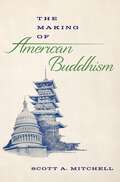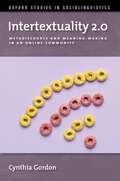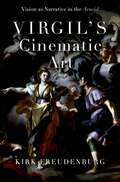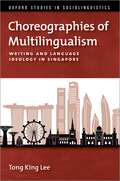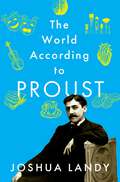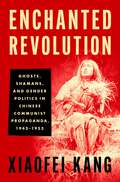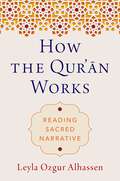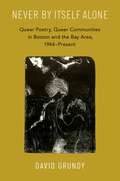- Table View
- List View
The Making of American Buddhism
by Scott A. MitchellAs of 2010, there were approximately 3-4 million Buddhists in the United States, and that figure is expected to grow significantly. Beyond the numbers, the influence of Buddhism can be felt throughout the culture, with many more people practicing meditation, for example, than claiming Buddhist identity. A century ago, this would have been unthinkable. So how did Buddhism come to claim such a significant place in the American cultural landscape? The Making of American Buddhism offers an answer, showing how in the years on either side of World War II second-generation Japanese American Buddhists laid claim to an American identity inclusive of their religious identity. In the process they-and their allies-created a place for Buddhism in America. These sons and daughters of Japanese immigrants-known as "Nisei," Japanese for "second-generation"-clustered around the Berkeley Bussei, a magazine published from 1939 to 1960. In the pages of the Bussei and elsewhere, these Nisei Buddhists argued that Buddhism was both what made them good Americans and what they had to contribute to America-a rational and scientific religion of peace. The Making of American Buddhism also details the behind-the-scenes labor that made Buddhist modernism possible. The Bussei was one among many projects that were embedded within Japanese American Buddhist communities and connected to national and transnational networks that shaped and allowed for the spread of modernist Buddhist ideas. In creating communities, publishing magazines, and hosting scholarly conventions and translation projects, Nisei Buddhists built the religious infrastructure that allowed the later Buddhist modernists, Beat poets, and white converts who are often credited with popularizing Buddhism to flourish. Nisei activists didn't invent American Buddhism, but they made it possible.
Intertextuality 2.0: Metadiscourse and Meaning-Making in an Online Community (OXFORD STUDIES SOCIOLINGUISTICS SERIES)
by Cynthia Gordon"Intertextuality" is the overarching idea that all texts and conversations are linked to other texts and conversations, and that people create and infer meanings in discourse through making and interpreting these links. Intertextuality is fundamentally connected to metadiscourse; when a person draws on or references one text or conversation in another (intertextuality), they necessarily communicate something about that text or conversation (metadiscourse). While scholars have long recognized the interrelatedness of these two theoretical concepts, existing studies have tended to focus on one or the other, leaving underexplored the specific ways in which these phenomena are intertwined at the micro-interactional level, especially online, and for what purposes. This interactional sociolinguistic study contributes to filling this gap by demonstrating how specific intertextual linking strategies, both linguistic (e.g., word repetition, deictic pronouns) and multimodal (e.g., emojis, symbols, and GIFs), are mobilized by posters participating in online weight loss discussion boards. These strategies serve as a resource to accomplish the metadiscursive activities, targeted at various levels of discourse, through which participants construct shared understandings, negotiate the group's interactional norms, and facilitate engagement in the group's primary shared activity: exchanging information about, and providing support for, weight loss, healthful eating, and related issues. By rigorously applying the perspective of metadiscourse in a study of intertextuality, Intertextuality 2.0 offers important new insights into why intertextuality occurs and what it accomplishes: it helps people manage the challenges of communication.
Intertextuality 2.0: Metadiscourse and Meaning-Making in an Online Community (OXFORD STUDIES SOCIOLINGUISTICS SERIES)
by Cynthia Gordon"Intertextuality" is the overarching idea that all texts and conversations are linked to other texts and conversations, and that people create and infer meanings in discourse through making and interpreting these links. Intertextuality is fundamentally connected to metadiscourse; when a person draws on or references one text or conversation in another (intertextuality), they necessarily communicate something about that text or conversation (metadiscourse). While scholars have long recognized the interrelatedness of these two theoretical concepts, existing studies have tended to focus on one or the other, leaving underexplored the specific ways in which these phenomena are intertwined at the micro-interactional level, especially online, and for what purposes. This interactional sociolinguistic study contributes to filling this gap by demonstrating how specific intertextual linking strategies, both linguistic (e.g., word repetition, deictic pronouns) and multimodal (e.g., emojis, symbols, and GIFs), are mobilized by posters participating in online weight loss discussion boards. These strategies serve as a resource to accomplish the metadiscursive activities, targeted at various levels of discourse, through which participants construct shared understandings, negotiate the group's interactional norms, and facilitate engagement in the group's primary shared activity: exchanging information about, and providing support for, weight loss, healthful eating, and related issues. By rigorously applying the perspective of metadiscourse in a study of intertextuality, Intertextuality 2.0 offers important new insights into why intertextuality occurs and what it accomplishes: it helps people manage the challenges of communication.
Virgil's Cinematic Art: Vision as Narrative in the Aeneid
by Kirk FreudenburgVirgil's Cinematic Art concerns the rhetoric of visual manipulation that provokes us to envision what is written on the page, treating visual details in ancient epic not as mere scene-setting information or enhancements to any given story, but as cues for performing specific imaginative processes. Through a series of close readings centered primarily on Virgil's Aeneid, Kirk Freudenburg shows that the experiential effects that Virgil puts into play do serious narrative work of their own by structuring lines of sight, both visual and emotive, and shifting them about in ways that move readers (interpellated as viewers) into and out of the visual and emotional worlds of the story's characters. Studies of visualization in Latin poetry have tended to treat what is seen in epic as a matter of what is there to be seen, rather than an expression of how someone sees, treating images as mostly static. This study, by contrast, concerns the cinematics of ancient narrative: how words provoke an active, forward-moving process of experiential participation; poets not as verbal painters, but as projectors, purveyors of imagined happenings. Informed by cognitivist and constructivist studies of how audiences watch narrative films and make sense of what they are being given to see, Freudenburg locates new narrative content lurking in old places, brought to life within the imaginations of readers. The end result is a new approach to the question of how ancient epic tales convey narrative content through visual means.
Virgil's Cinematic Art: Vision as Narrative in the Aeneid
by Kirk FreudenburgVirgil's Cinematic Art concerns the rhetoric of visual manipulation that provokes us to envision what is written on the page, treating visual details in ancient epic not as mere scene-setting information or enhancements to any given story, but as cues for performing specific imaginative processes. Through a series of close readings centered primarily on Virgil's Aeneid, Kirk Freudenburg shows that the experiential effects that Virgil puts into play do serious narrative work of their own by structuring lines of sight, both visual and emotive, and shifting them about in ways that move readers (interpellated as viewers) into and out of the visual and emotional worlds of the story's characters. Studies of visualization in Latin poetry have tended to treat what is seen in epic as a matter of what is there to be seen, rather than an expression of how someone sees, treating images as mostly static. This study, by contrast, concerns the cinematics of ancient narrative: how words provoke an active, forward-moving process of experiential participation; poets not as verbal painters, but as projectors, purveyors of imagined happenings. Informed by cognitivist and constructivist studies of how audiences watch narrative films and make sense of what they are being given to see, Freudenburg locates new narrative content lurking in old places, brought to life within the imaginations of readers. The end result is a new approach to the question of how ancient epic tales convey narrative content through visual means.
Choreographies of Multilingualism: Writing and Language Ideology in Singapore (OXFORD STUDIES SOCIOLINGUISTICS SERIES)
by Tong King LeeSingapore boasts a complex mix of languages and is therefore a rich site for the study of multilingualism and multilingual society. In particular, writing is a key medium in the production of the nation's multilingual order - one that is often used to organize language relations for public consumption. In Choreographies of Multilingualism, Tong King Lee examines the linguistic landscape of written language in Singapore - from street signage and advertisements, to institutional anthologies and text-based memorabilia, to language primers and social media-based poetry - to reveal the underpinning language ideologies and how those ideologies figure in political tensions. The book analyzes the competing official and grassroots narratives around multilingualism and takes a nuanced approach to discuss the marginalization, celebration, or appropriation of Singlish. Bringing together theoretical perspectives from sociolinguistics, multimodal semiotics, translation, and cultural studies, Lee demonstrates that multilingualism in Singapore is an emergent and evolving construct through which identities and ideologies are negotiated and articulated. Broad-ranging and cross-disciplinary, this book offers a significant contribution to our understanding of language in Singapore, and more broadly to our understanding of multilingualism and the sociolinguistics of writing.
Choreographies of Multilingualism: Writing and Language Ideology in Singapore (OXFORD STUDIES SOCIOLINGUISTICS SERIES)
by Tong King LeeSingapore boasts a complex mix of languages and is therefore a rich site for the study of multilingualism and multilingual society. In particular, writing is a key medium in the production of the nation's multilingual order - one that is often used to organize language relations for public consumption. In Choreographies of Multilingualism, Tong King Lee examines the linguistic landscape of written language in Singapore - from street signage and advertisements, to institutional anthologies and text-based memorabilia, to language primers and social media-based poetry - to reveal the underpinning language ideologies and how those ideologies figure in political tensions. The book analyzes the competing official and grassroots narratives around multilingualism and takes a nuanced approach to discuss the marginalization, celebration, or appropriation of Singlish. Bringing together theoretical perspectives from sociolinguistics, multimodal semiotics, translation, and cultural studies, Lee demonstrates that multilingualism in Singapore is an emergent and evolving construct through which identities and ideologies are negotiated and articulated. Broad-ranging and cross-disciplinary, this book offers a significant contribution to our understanding of language in Singapore, and more broadly to our understanding of multilingualism and the sociolinguistics of writing.
Propositions: Ontology and Logic (RUTGERS LECTURES IN PHILOSOPHY SERIES)
by Robert StalnakerIn the third volume in the Rutgers Lectures in Philosophy series, distinguished philosopher Robert Stalnaker here offers a defense of an ontology of propositions, and of some logical resources for representing them. He offers an austere formulation of a theory of propositions in a first-order extensional logic, but then uses the commitments of this theory to justify an enrichment to modal logic as an appropriate framework for regimented languages that are constructed to represent any of our scientific and philosophical commitments. His book adopts a self-consciously neo-Quinean methodology, and argues that the theory that is developed helps to motivate and clarify Quine's naturalistic metaphysical picture.
Propositions: Ontology and Logic (RUTGERS LECTURES IN PHILOSOPHY SERIES)
by Robert StalnakerIn the third volume in the Rutgers Lectures in Philosophy series, distinguished philosopher Robert Stalnaker here offers a defense of an ontology of propositions, and of some logical resources for representing them. He offers an austere formulation of a theory of propositions in a first-order extensional logic, but then uses the commitments of this theory to justify an enrichment to modal logic as an appropriate framework for regimented languages that are constructed to represent any of our scientific and philosophical commitments. His book adopts a self-consciously neo-Quinean methodology, and argues that the theory that is developed helps to motivate and clarify Quine's naturalistic metaphysical picture.
The United States of English: The American Language from Colonial Times to the Twenty-First Century
by Rosemarie OstlerThe story of how English became American -- and how it became Southern, Bostonian, Californian, African-American, Chicano, elite, working-class, urban, rural, and everything in between By the time of the Revolution, the English that Americans spoke was recognizably different from the British variety. Americans added dozens of new words to the language, either borrowed from Native Americans (raccoon, persimmon, caucus) or created from repurposed English (backwoods, cane brake, salt lick). Americans had their own pronunciations (bath rhymed with hat, not hot) and their own spelling (honor, not honour), not to mention a host of new expressions that grew out of the American landscape and culture (blaze a trail, back track, pull up stakes). Americans even invented their own slang, like stiff as a ringbolt to mean drunk. American English has continued to grow and change ever since. The United States of English tells the engrossing tale of how the American language evolved over four hundred years, explaining both how and why it changed and which parts of the "mother tongue" it preserved (I guess was heard in the British countryside long before it became a typical Americanism). Rosemarie Ostler approaches American English as part of the larger story of American history and culture, starting with what we know about the first colonists and their speech. Drawing on the latest research, she explores the roots of regional dialects, the differences between British and American language use, the sources of American slang, the development of African American English, current trends in political language, and much more. Plentiful examples of the American vernacular, past and present, bring the language to life and make for an engaging as well as enlightening read.
The United States of English: The American Language from Colonial Times to the Twenty-First Century
by Rosemarie OstlerThe story of how English became American -- and how it became Southern, Bostonian, Californian, African-American, Chicano, elite, working-class, urban, rural, and everything in between By the time of the Revolution, the English that Americans spoke was recognizably different from the British variety. Americans added dozens of new words to the language, either borrowed from Native Americans (raccoon, persimmon, caucus) or created from repurposed English (backwoods, cane brake, salt lick). Americans had their own pronunciations (bath rhymed with hat, not hot) and their own spelling (honor, not honour), not to mention a host of new expressions that grew out of the American landscape and culture (blaze a trail, back track, pull up stakes). Americans even invented their own slang, like stiff as a ringbolt to mean drunk. American English has continued to grow and change ever since. The United States of English tells the engrossing tale of how the American language evolved over four hundred years, explaining both how and why it changed and which parts of the "mother tongue" it preserved (I guess was heard in the British countryside long before it became a typical Americanism). Rosemarie Ostler approaches American English as part of the larger story of American history and culture, starting with what we know about the first colonists and their speech. Drawing on the latest research, she explores the roots of regional dialects, the differences between British and American language use, the sources of American slang, the development of African American English, current trends in political language, and much more. Plentiful examples of the American vernacular, past and present, bring the language to life and make for an engaging as well as enlightening read.
The World According to Proust
by Joshua Landy100 years after Proust's death, In Search of Lost Time remains one of the greatest works in World Literature. At 3,000 pages, it can be intimidating to some. This short volume invites first-time readers and veterans alike to view the novel in a new way. Marcel Proust (1871-1922) was arguably France's best-known literary writer. He was the author of stories, essays, translations, and a 3,000-page novel, In Search of Lost Time (1913-27). This book is a brief guide to Proust's magnum opus in which Joshua Landy invites the reader to view the novel as a single quest-a quest for purpose, enchantment, identity, connection, and belonging- through the novel's fascinating treatments of memory, society, art, same-sex desire, knowledge, self-understanding, self-fashioning, and the unconscious mind. Landy also shows why the questions Proust raises are important and exciting for all of us: how we can feel at home in the world; how we can find genuine connection with other human beings; how we can find enchantment in a world without God; how art can transform our lives; whether an artist's life can shed light on their work; what we can know about the world, other people, and ourselves; when not knowing is better than knowing; how sexual orientation affects questions of connection and identity; who we are, deep down; what memory tells us about our inner world; why it might be good to think of our life as a story; how we can feel like a single, unified person when we are torn apart by change and competing desires. Finally, Landy suggests why it's worthwhile to read the novel itself-how the long, difficult, but joyous experience of making it through 3,000 pages of prose can be transformative for our minds and souls.
The World According to Proust
by Joshua Landy100 years after Proust's death, In Search of Lost Time remains one of the greatest works in World Literature. At 3,000 pages, it can be intimidating to some. This short volume invites first-time readers and veterans alike to view the novel in a new way. Marcel Proust (1871-1922) was arguably France's best-known literary writer. He was the author of stories, essays, translations, and a 3,000-page novel, In Search of Lost Time (1913-27). This book is a brief guide to Proust's magnum opus in which Joshua Landy invites the reader to view the novel as a single quest-a quest for purpose, enchantment, identity, connection, and belonging- through the novel's fascinating treatments of memory, society, art, same-sex desire, knowledge, self-understanding, self-fashioning, and the unconscious mind. Landy also shows why the questions Proust raises are important and exciting for all of us: how we can feel at home in the world; how we can find genuine connection with other human beings; how we can find enchantment in a world without God; how art can transform our lives; whether an artist's life can shed light on their work; what we can know about the world, other people, and ourselves; when not knowing is better than knowing; how sexual orientation affects questions of connection and identity; who we are, deep down; what memory tells us about our inner world; why it might be good to think of our life as a story; how we can feel like a single, unified person when we are torn apart by change and competing desires. Finally, Landy suggests why it's worthwhile to read the novel itself-how the long, difficult, but joyous experience of making it through 3,000 pages of prose can be transformative for our minds and souls.
Adverbial Resumption in Verb Second Languages (OXFORD STUDIES COMPARATIVE SYNTAX SERIES)
While Verb-third (V3) patterns have long been studied in verb-second (V2) languages, a similar pattern in which an initial adverbial constituent is resumed by a clause-internal element has been much less studied. The latter is referred to as 'adverbial resumption' and it also has the character of being a V3 phenomenon. Therefore, the pattern is labelled 'adverbial V3 resumption' or 'adverbial V3.' The present volume is an up-to-date overview of the subject featuring case studies of individual languages that display certain patterns of V3. The authors discuss this pattern in relation to several different languages, addressing among other things issues of microvariation in contemporary varieties and diachronic variation. The book covers Medieval Romance, Old Italian, Old English, diachronic and synchronic varieties of German, varieties of Flemish and Dutch, Icelandic, varieties of Swedish, and Norwegian. Through analyses of adverbial resumptive V3 orders in Germanic and Romance, the contributors explore the nature of V2: while adverbial resumption only occurs in varieties that observe the V2 rule, in itself it leads to apparent violations of linear V2 order, namely to V3 orders. Adverbial Resumption in Verb Second Languages provides comparative analyses which touch upon the nature of sentence-external versus sentence-internal adjuncts, and the fine-grained architecture of the clausal functional hierarchy. These papers constitute a valuable contribution to the theoretically important topics of V2 and V3 that will be of interest to comparative linguists, Germanic linguistics, Romance linguists, and anyone working on formal grammar in general.
Adverbial Resumption in Verb Second Languages (OXFORD STUDIES COMPARATIVE SYNTAX SERIES)
by Karen De Clercq, Liliane Haegeman, Terje Lohndal and Christine MeklenborgWhile Verb-third (V3) patterns have long been studied in verb-second (V2) languages, a similar pattern in which an initial adverbial constituent is resumed by a clause-internal element has been much less studied. The latter is referred to as 'adverbial resumption' and it also has the character of being a V3 phenomenon. Therefore, the pattern is labelled 'adverbial V3 resumption' or 'adverbial V3.' The present volume is an up-to-date overview of the subject featuring case studies of individual languages that display certain patterns of V3. The authors discuss this pattern in relation to several different languages, addressing among other things issues of microvariation in contemporary varieties and diachronic variation. The book covers Medieval Romance, Old Italian, Old English, diachronic and synchronic varieties of German, varieties of Flemish and Dutch, Icelandic, varieties of Swedish, and Norwegian. Through analyses of adverbial resumptive V3 orders in Germanic and Romance, the contributors explore the nature of V2: while adverbial resumption only occurs in varieties that observe the V2 rule, in itself it leads to apparent violations of linear V2 order, namely to V3 orders. Adverbial Resumption in Verb Second Languages provides comparative analyses which touch upon the nature of sentence-external versus sentence-internal adjuncts, and the fine-grained architecture of the clausal functional hierarchy. These papers constitute a valuable contribution to the theoretically important topics of V2 and V3 that will be of interest to comparative linguists, Germanic linguistics, Romance linguists, and anyone working on formal grammar in general.
Language, Science, and Structure: A Journey into the Philosophy of Linguistics
by Ryan M. NefdtWhat is a language? What do scientific grammars tell us about the structure of individual languages and human language in general? What kind of science is linguistics? These and other questions are the subject of Ryan M. Nefdt's Language, Science, and Structure. Linguistics presents a unique and challenging subject matter for the philosophy of science. As a special science, its formalisation and naturalisation inspired what many consider to be a scientific revolution in the study of mind and language. Yet radical internal theory change, multiple competing frameworks, and issues of modelling and realism have largely gone unaddressed in the field. Nefdt develops a structural realist perspective on the philosophy of linguistics which aims to confront the aforementioned topics in new ways while expanding the outlook toward new scientific connections and novel philosophical insights. On this view, languages are real patterns which emerge from complex biological systems. Nefdt's exploration of this novel view will be especially valuable to those working in formal and computational linguistics, cognitive science, and the philosophies of science, mathematics, and language.
Language, Science, and Structure: A Journey into the Philosophy of Linguistics
by Ryan M. NefdtWhat is a language? What do scientific grammars tell us about the structure of individual languages and human language in general? What kind of science is linguistics? These and other questions are the subject of Ryan M. Nefdt's Language, Science, and Structure. Linguistics presents a unique and challenging subject matter for the philosophy of science. As a special science, its formalisation and naturalisation inspired what many consider to be a scientific revolution in the study of mind and language. Yet radical internal theory change, multiple competing frameworks, and issues of modelling and realism have largely gone unaddressed in the field. Nefdt develops a structural realist perspective on the philosophy of linguistics which aims to confront the aforementioned topics in new ways while expanding the outlook toward new scientific connections and novel philosophical insights. On this view, languages are real patterns which emerge from complex biological systems. Nefdt's exploration of this novel view will be especially valuable to those working in formal and computational linguistics, cognitive science, and the philosophies of science, mathematics, and language.
Enchanted Revolution: Ghosts, Shamans, and Gender Politics in Chinese Communist Propaganda, 1942-1953
by Xiaofei KangEnchanted Revolution moves religion and gender to center stage in the Chinese Communist revolution, examining the mobilizational dynamics of anti-superstition propaganda in support of the Communist Party's rise from rural backwaters to national dominance. Xiaofei Kang argues that religion was not merely adversary for the revolutionaries-it also served as a model for the ways in which the Party mobilized support and constructed legitimacy. In this parallel and often paradoxical process, the Party attacked "superstitions" that had long supported the foundations of Chinese religious life. At the same time, Party propaganda co-opted these same religious resources for its own political ends. Kang demonstrates that the persuasive power of Party propaganda relied heavily on recasting the cosmic forces of yin and yang that sustained the traditional gender hierarchy and ritual order. Moreover, revolutionary art and literature revamped old narratives of female ghosts and ritual exorcism to inject the people with a new masculinist vision of the Party-state endowed with both scientific potency and the heavenly mandate. Gendered language and symbolism in Chinese religion thus remained central to inspiring pathos, ethos, and logos for the revolution. Enchanted Revolution sheds light on the contemporary significance of the Maoist legacy in China through a deft exploration of the complex interplay of religion, gender, and revolution.
Enchanted Revolution: Ghosts, Shamans, and Gender Politics in Chinese Communist Propaganda, 1942-1953
by Xiaofei KangEnchanted Revolution moves religion and gender to center stage in the Chinese Communist revolution, examining the mobilizational dynamics of anti-superstition propaganda in support of the Communist Party's rise from rural backwaters to national dominance. Xiaofei Kang argues that religion was not merely adversary for the revolutionaries-it also served as a model for the ways in which the Party mobilized support and constructed legitimacy. In this parallel and often paradoxical process, the Party attacked "superstitions" that had long supported the foundations of Chinese religious life. At the same time, Party propaganda co-opted these same religious resources for its own political ends. Kang demonstrates that the persuasive power of Party propaganda relied heavily on recasting the cosmic forces of yin and yang that sustained the traditional gender hierarchy and ritual order. Moreover, revolutionary art and literature revamped old narratives of female ghosts and ritual exorcism to inject the people with a new masculinist vision of the Party-state endowed with both scientific potency and the heavenly mandate. Gendered language and symbolism in Chinese religion thus remained central to inspiring pathos, ethos, and logos for the revolution. Enchanted Revolution sheds light on the contemporary significance of the Maoist legacy in China through a deft exploration of the complex interplay of religion, gender, and revolution.
How the Qur'=an Works: Reading Sacred Narrative
by Leyla Ozgur AlhassenThe Qur'an is a text of extraordinary depth and complexity. In How the Qur'an Works, Leyla Ozgur Alhassen takes the reader on a journey through the Qur'an, moving from one verse to another, one story to another, focusing on narratological elements while conducting a close reading in order to understand particular Qur'anic stories and to show how the text's literary techniques enhance its theological agenda. She unpacks the text by focusing on Qur'anic narrative, and specifically, repetition in Qur'anic stories. Repetition is an important part of the Qur'an's literary technique. Ozgur Alhassen traces the use of repetition as a narrative device from the text's overall structure to individual letters. She compares different Qur'anic stories and explores the kinds of repetition that occur in them and what purposes they serve. Repetition, she shows, forges patterns, connections, and layers of meaning that develop, complicate, and comment on the Qur'an's messages.
How the Qur'=an Works: Reading Sacred Narrative
by Leyla Ozgur AlhassenThe Qur'an is a text of extraordinary depth and complexity. In How the Qur'an Works, Leyla Ozgur Alhassen takes the reader on a journey through the Qur'an, moving from one verse to another, one story to another, focusing on narratological elements while conducting a close reading in order to understand particular Qur'anic stories and to show how the text's literary techniques enhance its theological agenda. She unpacks the text by focusing on Qur'anic narrative, and specifically, repetition in Qur'anic stories. Repetition is an important part of the Qur'an's literary technique. Ozgur Alhassen traces the use of repetition as a narrative device from the text's overall structure to individual letters. She compares different Qur'anic stories and explores the kinds of repetition that occur in them and what purposes they serve. Repetition, she shows, forges patterns, connections, and layers of meaning that develop, complicate, and comment on the Qur'an's messages.
Never By Itself Alone: Queer Poetry, Queer Communities in Boston and the Bay Area, 1944?Present
by David GrundyProviding an unprecedented exploration of key moments in queer literary history, Never By Itself Alone changes our sense of both the American literary and political landscapes from the late 1940s through the 21st century. Grundy presents the first comprehensive history of post-war queer writing in Boston and San Francisco, intertwining analysis of lesbian, gay, and queer writing, and insisting on the link between activism and literature. The book centers a host of underrepresented writers, especially writers of color and those with gender non-conforming identities, and challenges the Stonewall exceptionalism of queer historiography. Starting with Robert Duncan's 1944 essay, 'The Homosexual in Society', one of the first significant public defenses of homosexuality in the US, Grundy takes the reader through pioneering works by queer voices of the era, including Adrian Stanford's Black and Queer, the first published book by an out, Black gay poet in the US; the Boston collective Fag Rag and their radical reconsideration of family, private property and the State; the Combahee River Collective, whose Black Feminist analysis drew together race, class, and sexuality; the anthology This Bridge Called My Back, in which women of color spoke truth to power, together; and New Narrative writing, which audaciously mixed Marxism, porn and gossip while uniting against the New Right. Linking these works to the context which produced them, Grundy uncovers the communities formed around activism and small press publishing during this era and elevates neglected voices to narrate a history that before now has never been told in its entirety. Drawing on extensive archival research, Never By Itself Alone is a rigorous and unmatched work of both literary criticism and queer scholarship which underscores the vital importance of radical accounts of race, class, and gender in any queer studies worthy of the name.
Never By Itself Alone: Queer Poetry, Queer Communities in Boston and the Bay Area, 1944?Present
by David GrundyProviding an unprecedented exploration of key moments in queer literary history, Never By Itself Alone changes our sense of both the American literary and political landscapes from the late 1940s through the 21st century. Grundy presents the first comprehensive history of post-war queer writing in Boston and San Francisco, intertwining analysis of lesbian, gay, and queer writing, and insisting on the link between activism and literature. The book centers a host of underrepresented writers, especially writers of color and those with gender non-conforming identities, and challenges the Stonewall exceptionalism of queer historiography. Starting with Robert Duncan's 1944 essay, 'The Homosexual in Society', one of the first significant public defenses of homosexuality in the US, Grundy takes the reader through pioneering works by queer voices of the era, including Adrian Stanford's Black and Queer, the first published book by an out, Black gay poet in the US; the Boston collective Fag Rag and their radical reconsideration of family, private property and the State; the Combahee River Collective, whose Black Feminist analysis drew together race, class, and sexuality; the anthology This Bridge Called My Back, in which women of color spoke truth to power, together; and New Narrative writing, which audaciously mixed Marxism, porn and gossip while uniting against the New Right. Linking these works to the context which produced them, Grundy uncovers the communities formed around activism and small press publishing during this era and elevates neglected voices to narrate a history that before now has never been told in its entirety. Drawing on extensive archival research, Never By Itself Alone is a rigorous and unmatched work of both literary criticism and queer scholarship which underscores the vital importance of radical accounts of race, class, and gender in any queer studies worthy of the name.
The Great Nation of Futurity: The Discourse and Temporality of American National Identity (OXFORD STUDIES SOCIOLINGUISTICS SERIES)
by Patricia DunmireThe Great Nation of Futurity is situated within the discourse and ideology of American exceptionalism which has undergirded the nation's identity throughout its history. It draws out the temporal dimension of the exceptionalist ideology, namely the construal of America as the "great nation of futurity," and examines how this identity manifests linguistically and functions rhetorically in Cold War foreign policy discourse. Working within a critical discourse analytic framework, Patricia L. Dunmire examines the space-times construed within foreign policy discourse and demonstrates that these consistently position the United States in a privileged position vis-à-vis the future. This positioning, in turn, sanction a foreign policy approach focused on global future design.
The Great Nation of Futurity: The Discourse and Temporality of American National Identity (OXFORD STUDIES SOCIOLINGUISTICS SERIES)
by Patricia DunmireThe Great Nation of Futurity is situated within the discourse and ideology of American exceptionalism which has undergirded the nation's identity throughout its history. It draws out the temporal dimension of the exceptionalist ideology, namely the construal of America as the "great nation of futurity," and examines how this identity manifests linguistically and functions rhetorically in Cold War foreign policy discourse. Working within a critical discourse analytic framework, Patricia L. Dunmire examines the space-times construed within foreign policy discourse and demonstrates that these consistently position the United States in a privileged position vis-à-vis the future. This positioning, in turn, sanction a foreign policy approach focused on global future design.
